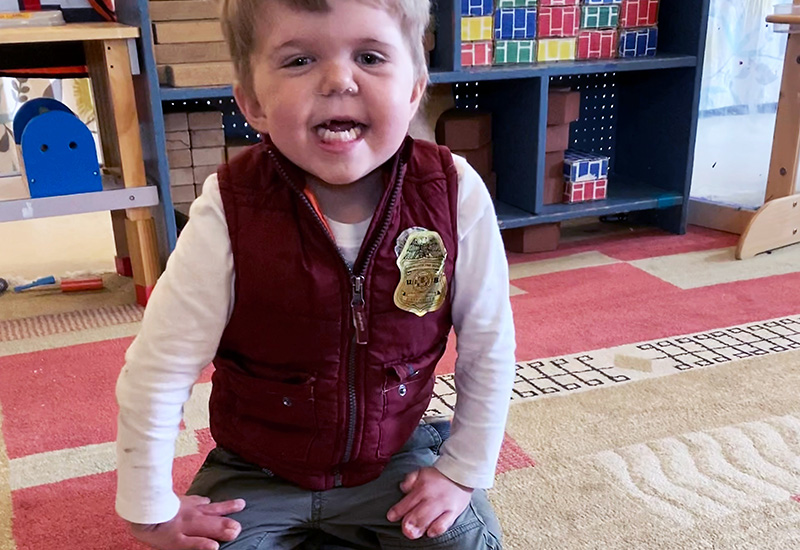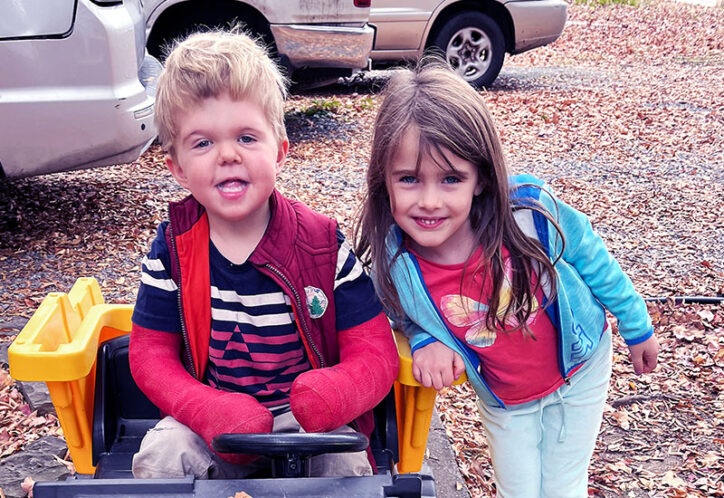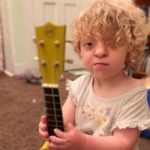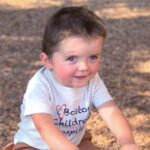Sonny’s story: How an online Apert syndrome community set one family on a path to Boston

Sonny Daniel has had a busy summer. Between traveling, camp, and time with family and friends, this 4-year-old has constantly been on the go — something his parents, Kellie and Josh, are incredibly grateful for.
Their gratitude stems a lot from seeing how far Sonny’s come in his journey with Apert syndrome, a genetic disorder that causes the skull, hands, and feet bones to fuse and that had the potential to restrict brain growth and physical abilities. Thankfully, Sonny’s journey is also one that introduced the family to a community of lifelong friends and to Boston Children’s Hospital, where Sonny receives care from Dr. Brian Labow, Dr. Amir Taghinia, and others in the Craniofacial Program.
A welcoming community after a surprise diagnosis
Sonny having Apert syndrome came as a surprise to Kellie and Josh.
“I had a textbook pregnancy: No problems or complications, and all my ultrasounds were normal,” Kellie says. She recalls a whirlwind of emotions in the moments after Sunny arrived.
“We didn’t find out Sonny’s gender during my pregnancy, so I remember Josh joyfully shouting, ‘it’s a boy!’ the moment he arrived,” Kellie says. “Then the doctor placed Sonny in my arms, and I immediately scanned for 10 fingers and toes. I noticed all the digits were there, but they were fused together. Then the team whisked our boy away for further examination and eventually to the NICU.”
In addition to fused fingers and toes, babies with Apert syndrome often exhibit:
– a long skull and high, prominent forehead
– an underdeveloped upper jaw
– prominent eyes that appear to be bulging out and might be spaced widely apart
– a small nose
Sonny was diagnosed with Apert syndrome within 24 hours of his birth while still in the NICU, with a confirmed diagnosis coming a couple of months later. Kellie and Josh went straight to work looking for ways to help their son.
“Almost immediately, Josh found a Facebook group for children and adults from around the world with Apert syndrome,” Kellie says.
A resounding message the couple received from the group was to contact Boston Children’s to address Sonny’s hands, specifically separating his fingers. But treating Sonny’s skull came first.
“That was our priority,” Kellie says. “We had been anticipating skull surgery since his birth.”
Because Apert syndrome causes the skull bones to fuse too early (a condition called craniosynostosis), which can cause slower mental development due to the abnormal growth of the skull, children with Apert syndrome typically undergo surgery to separate the fused skull bones and release the pressure their growing brain is putting on their skull and face.
Sonny underwent skull release surgery in March 2020 near home in Charlotte, North Carolina.
A path to separation
Following a smooth recovery and joyful summer as a family, Kellie and Josh started looking into separating Sonny’s fingers in the fall of 2020. In an effort to stay close to home and to the care teams they had grown to know, they first consulted two centers in North Carolina.
“Both hospitals said they wouldn’t separate all his fingers,” Kellie says. Their reasoning, she explains, is that both facilities believed Sonny would fare better with fused middle and ring fingers acting as one digit versus creating two thinner and potentially weaker fingers. While they weighed their options, Kellie and Josh remembered the advice from members of the Apert Facebook community who went to Boston Children’s from around the world for care. They reached out to the Craniofacial Program and heard back from the team within days.
“We had a virtual consult with Dr. Labow, and right away he said there was no reason they couldn’t separate Sonny’s fingers,” Kellie recalls. “That, without a doubt, is why we came to Boston.”
A staged approach
Dr. Labow and Dr Taghinia classified Sonny’s hands as type 1, meaning his index, middle, and ring fingers were webbed, but his thumbs were free. Separating them — through a procedure called syndactyly separation — would take a staged approach, meaning multiple surgeries.
“The reason we wouldn’t work on both sides of Sonny’s fingers at one time is that we’re borrowing skin from one side of his fused fingers to help reconstruct his hands,” says Dr. Labow. “We then use that skin to line the sides of the newly separated fingers. So, to avoid pulling or taxing his skin too much at one time, we will limit ourselves to only one side in each operation.”
Dr. Labow and Dr. Taghinia performed Sonny’s syndactyly separation in November 2021 — right before his fourth birthday.
“We typically like to have a child’s fingers separated within the first two or three years of their life because kids really use their hands to explore their environment,” Dr. Labow says. “And our belief is that by that giving them the best possible hand function early on, it’s going to help them engage and do the things they need to do.”

For Sunny, that list includes:
- running
- dancing, acrobatics with his sister Maddie
- climbing any slide he can find
- biking on a two-wheeler
- swimming
- basketball
- baseball
- puzzles
- coloring
- playing with Legos
- jamming on the guitar (or any instrument) with his dad — by far Sonny’s favorite thing to do
A happy camper
Sonny will return to Boston Children’s this fall for another syndactyly separation to release his two middle fingers. While the idea of having completely free hands excites Kellie and Josh, Sonny is pretty pleased with his own progress so far.
“He loves his hands; he likes to go over and over the names of each finger,” Kellie says. “He keeps looking at them, smiling, and saying, ‘I love my hands.’”
Learn more about the Craniofacial Program and the Department of Plastic and Oral Surgery at Boston Children’s Hospital.
Related Posts :
-

Maisie’s story: Our journey with Apert syndrome
Our daughter Maisie is 4 years old. She loves riding her bike, baking, jumping on the trampoline, and keeping up ...
-

There's no stopping Jack: His journey with craniosynostosis
Jack is almost 2 years old and loves to swim, chase his older sister around the house, and just bring lots ...
-

Minimally invasive surgery safe and effective for craniosynostosis
Traditional treatment for children with craniosynostosis — a condition in which the bones of the skull grow together too early in ...
-

A kiss from their sister: A family’s journey with cleft lip care
Kelly and Ben’s experience with cleft lip care at Boston Children’s Hospital spans multiple years and multiple children. ...





